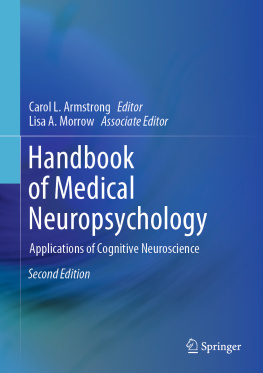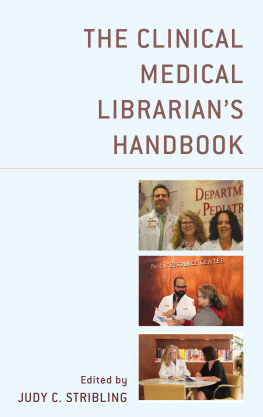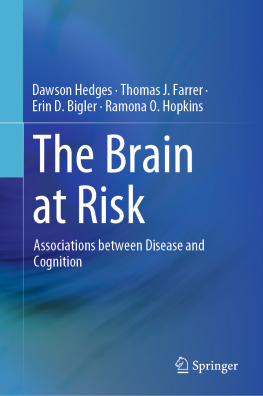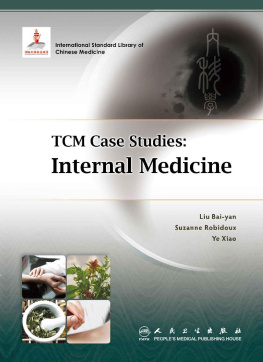Editors
Carol L. Armstrong
Perelman School of Medicine of the University of Pennsylvania, Philadelphia, PA, USA
Lisa A. Morrow Associate Editor
Western Psychiatric Institute and Clinic, Pittsburgh, PA, USA
ISBN 978-3-030-14894-2 e-ISBN 978-3-030-14895-9
https://doi.org/10.1007/978-3-030-14895-9
Library of Congress Control Number: 2019933186
Springer Nature Switzerland AG 2010, 2019
This work is subject to copyright. All rights are reserved by the Publisher, whether the whole or part of the material is concerned, specifically the rights of translation, reprinting, reuse of illustrations, recitation, broadcasting, reproduction on microfilms or in any other physical way, and transmission or information storage and retrieval, electronic adaptation, computer software, or by similar or dissimilar methodology now known or hereafter developed.
The use of general descriptive names, registered names, trademarks, service marks, etc. in this publication does not imply, even in the absence of a specific statement, that such names are exempt from the relevant protective laws and regulations and therefore free for general use.
The publisher, the authors and the editors are safe to assume that the advice and information in this book are believed to be true and accurate at the date of publication. Neither the publisher nor the authors or the editors give a warranty, expressed or implied, with respect to the material contained herein or for any errors or omissions that may have been made. The publisher remains neutral with regard to jurisdictional claims in published maps and institutional affiliations.
This Springer imprint is published by the registered company Springer Nature Switzerland AG
The registered company address is: Gewerbestrasse 11, 6330 Cham, Switzerland
Foreword to the First Edition
This handbook celebrates the abundantly productive interaction of neuropsychology and medicine. This interaction can be found in both clinical settings and research laboratories, often between research teams and clinical practitioners. It accounts for the rapidity with which awareness and understanding of the neuropsychological components of many common medical disorders have recently advanced. The introduction of neuropsychology into practice and research involving conditions without obvious neurological components follows older and eminently successful models of integrated care and treatment of the classical brain disorders.
In the last 50 years, with the growing understanding of neurological disorders, neuropsychologists and medical specialists in clinics, at bedside, and in laboratories together have contributed to important clinical and scientific advances in the understanding of the common pathological conditions of the brain: stroke, trauma, epilepsy, certain movement disorders, tumor, toxic conditions (mostly alcohol-related), and degenerative brain diseases. It is not surprising that these seven pathological conditions were the first to receive attention from neuropsychologists as their behavioral symptoms can be both prominent and debilitating, often with serious social and economic consequences.
However, many diseases affect behavior and cognition without directly involving brain substance. Yet only in the last two decades has a scientifically grounded understanding of the neuropsychological implications of such diseases become available as the neuropsychological enterprise broadened its purview from the common brain disorders to clinical care and research with patients whose medical conditions impaired their neuropsychological functioning. Thanks to the relatively recent emphasis on holistic medicine, physicians have increasingly become sensitive to the often subtle but functionally important psychological alterations of medical patients without diagnosable brain disease. This has led many to neuropsychology for reliable knowledge about the behavioral ramifications of these patients disorders. This recent marriage of traditional medicine and neuropsychology has been most fruitful, as attested to in the sections that deal with metabolic and endocrine disorders in particular, but also in chapters concerned with specific vascular and immune-mediated disorders occurring outside the brain.
By including sections on developmental disorders and rehabilitation this handbook effectively covers the full range of conditions with neurocognitive ramifications. It will become apparent to the reader that the interplay of medicine and neuropsychology has made possible the science and skills for todays best practices in the care of patients with these conditions.
Of the eight sections in this handbook, the first is devoted exclusively to central nervous system disorders: Four of the six diagnostic categories considered in primary nervous system disease concern brain conditions in which neuropsychologists have been involved for more than three decades: movement disorders, epilepsy, traumatic brain injury, and neurooncology (e.g., [16]). Although these disorders differ greatly in their etiologies, developmental histories, course, and susceptibility to amelioration, what they have in common is the significant role that their neuropsychological symptoms play in determining the conduct and quality of the patients life. The large body of scientific literature for each of these categories testifies to the value of medical specialists and neuropsychologists working together on patient evaluation and treatment. Much of the research underlying improved care for these conditions comes from this cooperation and cross-fertilization.
A relative newcomer to the categories of neurological disorders with significant behavioral symptom is autonomic nervous system disorders . The recency of neuropsychologists involvement may account for the paucity of neuropsychologically relevant research into this condition. This chapter and others, such as Hydrocephalus, make it evident that understanding subcerebral disorders. Whether psychological interventions may also ease the cognitive and emotional symptoms of these conditions remains to be seen.
The end product of all cardiovascular diseases is reduced availability of oxygen. Thus, by their very nature, these diseases breed neuropsychological disorders as a result of insufficient oxygenation of highly oxygen-dependent brain substance. Their neuropsychological symptoms vary, from the sudden, often dramatic, loss of significant abilities due to stroke or the progressive cognitive withering of vascular dementia to the subtle dampening of cognitive acuity that occurs with primary breathing disorders or the intermittent diminution of function accompanying many migraine headaches. The presentation of the broad range of cardiovascular disorders here should give the clinician an increased awareness of the neuropsychological manifestations of vascular disease, especially those all too common respiratory conditions in which subtle but important neuropsychological consequences have been unsuspected or overlooked, such as chronic obstructive pulmonary disease and sleep apnea.








